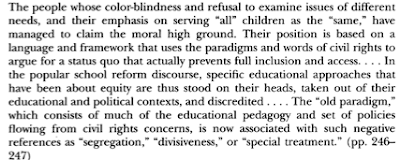Platt, E, Harper, C, & Mendoza, M.B. (2003). Dueling Philosophies: Inclusion or Separation for Florida’s English Language Learners? TESOL Quarterly, 37(1), 105-133.
Concerning English for Students of Other Languages (ESOL) education, two models surface: inclusion and separation. Many educators, administrators, and parents find themselves disagreeing with one another over which model serves English Language Learners, students, or their children the best. In Elizabeth Platt, Candace Harper, and Maria Beatriz Mendoza’s article “Dueling Philosophies: Inclusion or Separation for Florida’s English Language Learners,” the authors examine the separation model and inclusion model for ESOL instruction. Using data from 29 district-level ESL administrator interviews, Platt et al discuss the positive and negative of each model; however, the reader can note a heavy emphasis the authors place on the parallel trends inclusion shares with national and international contextual standardizations in the inclusion model (Platt et al, 2003). In addition, issues of impartiality for English language learners (ELLs) and the specialization of English as a Second Language (ESL)/English as a Foreign Language (EFL) teaching profession emerge as complications of continuing down an inclusive path.
When examining full inclusion, Platt et al (2003) explain that the inclusive prose or rhetoric removes ELLs from its “ideology of individualism and meritocracy” (108). But how does the much-advertised inclusive model remove ELLs from its umbrella ideology? One way to examine this detachment is through previously established separation models. Platt et al (2003), citing Laurie Olsen (1997), states
The authors explain the once educational pedagogy and policies, which stem from civil rights, are now stigmatized with negative associations like “segregation, divisiveness, or special treatment” (108); for example, bilingual and ESL programs name a few. Some educators, administrators, and/or parents may challenge Platt et al’s view by insisting full inclusion provides each individual with the same education and the same opportunities; nevertheless, the claims from Platt el al argue the recent trends in accountability and standardization of curriculum and assessment has excluded ELLs from the full inclusion model, which advocates for full participation and success in school (Platt et al, 2003).
On the other spectrum of an inclusive model, separation models aim to provide specialized services in a separate environment, which “facilitates equal access to the curriculum in a timely and effective manner” (Platt et al, 2003, pg 109); however, the problem with a separation model resides in how one defines discrimination. Educators, administrators, and parents opposed to a separation model find separating their students or children would breach various rights and acts; for instance, the Education for All Handicapped Children Act (1975), the Individuals With Disabilities Education Act (1997), and various individual liberties stemming from the Bill of Rights identify some of the various rights or acts a separation model might violate. However, due to the ambiguous specifications of the Office of Civil Rights (OCR) of what accurately defined discrimination, many separation instructional programs (bilingual and ESL programs) went under heavy scrutiny from methods potentially discriminatory (Platt et al, 2003).
Even though both models provide pros and cons, my perspective of Platt et al’s article falls in the successfully educating of ELLs. According to the article, research has been presented to support both models. On the one hand, I agree with Platt et al that the inclusion model has drifted away from its purpose to provide equity to all students; however, I still insist teachers, administrators, and parents show strive towards the success and excellence of educating ELLs. Is the inclusion model better, or the separation model? Although I recognize the much-advertised inclusion model’s ideology, and the inclusive drift that is to follow—according to Platt et al, I still maintain that our primary goal is the successful and excellence of education ELLs, whether in a inclusion model or separation model.

Great Information sharing .. I am very happy to read this article .. thanks for giving us go through info.Fantastic nice. I appreciate this post. şişli ingilizce kursu
ReplyDelete